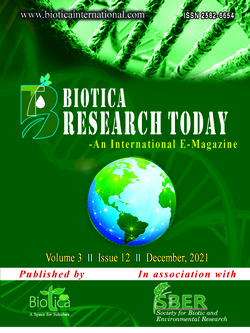
Plant Nutrient Availability Mediated by Soil Reaction
M. K. Meena*
ICAR- Directors of Rapeseed-Mustard Research, Bharatpur, Rajasthan (321 303), India
M. L. Dotaniya
ICAR- Directors of Rapeseed-Mustard Research, Bharatpur, Rajasthan (321 303), India
M. D. Meena
ICAR- Directors of Rapeseed-Mustard Research, Bharatpur, Rajasthan (321 303), India
R. S. Jat
ICAR- Directors of Rapeseed-Mustard Research, Bharatpur, Rajasthan (321 303), India
R. L. Chodhary
ICAR- Directors of Rapeseed-Mustard Research, Bharatpur, Rajasthan (321 303), India
Harvir Singh
ICAR- Directors of Rapeseed-Mustard Research, Bharatpur, Rajasthan (321 303), India
V. D. Meena
ICAR- Directors of Rapeseed-Mustard Research, Bharatpur, Rajasthan (321 303), India
C. K. Dotaniya
Dept. of Soil Science & Agricultural Chemistry, SKRAU, Bikaner, Rajasthan (334 006), India
DOI: NIL
Keywords: Crop growth, Nutrient availability, Soil health, Soil pH
Abstract
By 2050, India would require around 333 million tonnes (MT) of food grain to feed its hungry population, compared to the estimated production of 297.5 MT in 2019-20. Chemical fertilizers are widely used in the agricultural crop production system. Since the beginning of the green revolution in Indian agriculture, this approach has become more prevalent. The green revolution included genetic advances (high-yielding cultivars), nutrient management (organic or inorganic), natural resource use (water), and agricultural chemical contributions (pesticides and fungicides). Now that the moment has come, scientists are focusing on the precise application of plant nutrient use efficiency in relation to crop yield. By mediating the soil rhizosphere, fertilizer is applied based on soil reaction. Crop productivity is influenced by the interrelated physical, chemical, and biological health of the soil, which is influenced by soil management practices in various ways.
Downloads
not found
Reference
Anonymous, 2016. Soil pH. Available at: http://hort.ufl.edu/database/trees/trees_scientific.shtml. Accessed on: 02.12.2021.
Dotaniya, M.L., Meena, V.D., 2013. Rhizosphere effect on nutrient availability in soil and its uptake by plants - a review. Proceedings of the National Academy of Sciences, India Section B: Biological Sciences 85(1), 1-12.
Dotaniya, M.L., Meena, B.P., 2017. Rhizodeposition by plants: A boon to soil health. In: Advances in nutrient dynamics in soil plant system for improving nutrient use efficiency (Elanchezhian R., Biswas A.K., Ramesh K., Patra A.K., eds.), New India Publishing Agency, New Delhi, India, pp. 207-224.
Ratan, R.K., Goswami, N.N., 2002. Essential nutrients and their uptake by plants. In: Fundamentals of Soil Science (Sekhon G.S., Chhonkar P.K., Das D.K. et al., eds.), Indian Society of Soil Science, New Delhi, pp. 309-332.
Reddy, S., 2019. Soil pH- an important factor in crop production. Available at: www.bighaat.com/blogs/kb/soil-ph-an-important-factor-in-crop-production. Accessed on: 07.12.2021.
